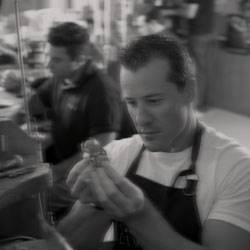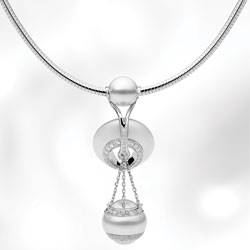Haute Joaillerie goes Aussie
 2.2 k views | By Nick Lord
2.2 k views | By Nick Lord
Is there such a thing as “Australian” jewellery design? NICK LORD chats
with five prominent jewellery designers about the uniqueness of our
nation’s jewellery.
When Jeweller first conceived the notion of a design-centric issue - one that breaks from regular convention to celebrate all that is romantic and artistic about jewellery - an interesting question arose: what exactly is Australian jewellery?
Rapidly, the office morphed into a hotbed of debate as staff grappled with the notion of Aussie design. Are there Australia-specific techniques? Do jewellers follow Australian design philosophies? Is there actually an “Aussie” approach to making jewellery and does it matter if there isn't?
Frustration ensued as the staff struggled to pinpoint the answers to these and other questions:
“Of course, Australian jewellery is different,” argued one writer.
“How?” another asked.
“Well... er... I can't describe it but I know it when I see it.”
With a deadline looming, Jeweller has called upon some experts: Russell Carr (NV Designer Jewellery, New South Wales), Peter Lee (Indivijewel, Victoria), Travis Thompson (Briolette Jewellers, Australian Capital Territory) and Paul Taseff (Linneys, Western Australia). These are four award-winning, local jewellery designers chosen to help decipher just what those differences are, and whether there is such a thing as an “Aussie” look.
Opening the proceedings, all participants agree that it is important to focus on celebrating Australian jewellery for its uniqueness, technical proficiency and quality of workmanship.
“Our designers are right up there with some of the best in the world,” Carr says. “I don't know whether the general trade believes that, but if you go to any jewellery awards, you'll see that Australian jewellery is very unique.”
“It's true. The quality of design in Australia is fantastic, at the top. Our best is as good as anyone in the world,” echoes Lee.
The group is less sure as to the question of whether Australian jewellery has a distinct look unto itself - one that separates it from Europe and America. Some critics have long argued that Australian designers lack individuality, relying heavily on international fashion trends and mostly taking inspiration from Europe's cue. Briolette Jewellers' Travis Thompson disagrees:
“The Aussie look might spin off Europe, sure, but we definitely have our own product and a different approach,” he says. “Though we follow European trends, we inject our own materials and our own style, and become more varied.
It's in the area of materials that Australia's burgeoning jewellery identity most apparent. The use of gemstones of local origin provide a nationalistic flavour that alone can trigger international demand, and it’s here the group turns when discussing the “Aussie” look.
“From my point of view, designing Australian is about the use of purely local stones,” Thompson continues. “We use a lot of opal and sapphire and these materials really set us apart. When the materials are different, the end result is different too.”
One demographic exploiting the point of difference that comes from using such materials is that of the West Australian jewellers. Taseff argues that the Australian look is entrenched in the work of west coast jewellers because of their outback locale and strong link to iconic Australian symbols and gemstones.
“Particularly where we are here in WA, we're strongly influenced by the materials we use,” Taseff says. “A lot of pieces are designed around Kimberly pink diamonds, Kalgoorlie gold and South Sea pearls and while this happens throughout Australia, Western Australian jewellers have a closer proximity to these resources and therefore feel closer to them.”
The notion that the Australian look is really a Western Australian look makes a lot of sense. Consider the deeply entrenched cultural stereotype overseas of the Aussie outback battler, iconography that effectively belongs to central and west Australia yet is borrowed by the east coast to enhance tourism, and one can see it’s been happening for years.
Taseff explains that Linneys not only allows this “Aussiness” to influence design, but also incorporates it into the marketing of its products, providing the completely Australian package to international shoppers.

Haute Joaillerie
“We're using [WA-born stars] Melissa George and Ernie Dingo to promote our jewellery at the moment,” Taseff explains. “They're wearing unique pearl pieces geared towards the international market in a campaign across print media and television. Linneys is purely Western Australian, which is what the business has prided itself on and this is the message we are marketing through magazines such as Vogue.”
Iconography aside, Taseff argues that the use of Australian materials such as South Sea pearls contributes also to the emergence of a different look from Europe by providing jewellers with an entirely different set of design boundaries, and therefore opening more creative possibilities.
“The attraction to local materials is natural, and certainly not driven solely by some need to be Australian,” Taseff says. “We have the best pearls in the world and the rarest pink diamonds, so why wouldn't we use those? It is in our best interests to capitalise upon what is available. The beauty is that these materials also provide different textures and shapes. Working with organic pearls, we're not restrained by the shape of a diamond cut, for example. This gives the jeweller greater creative scope because the gems are more fluid.”
While jewellers benefit from exclusivity of materials, it's possible to be just as Australian using generic metals and gems. Tapping into any of Australia's rich themes and iconic symbols is another way some jewellers are engineering a point of difference.
“An Australian look can come from using flora and fauna themes also,” Thompson says. “We've done gumleaf brooches with green and gold sapphires, for example, which are again totally unique in this country, so you're going to end up with something no one else has come up with.
“International visitors often want this flora and fauna replicated in their jewellery and pieces that show these Australian themes will generally do better overseas than here.”
Perhaps more influential than material or thematic factors, there's an underlying feeling that Australia's emerging design differences with Europe are forcibly imposed, as jewellers actually tone-down their influences to try to match less-
adventurous consumer tastes, making pieces geared towards achieving sales rather than creative expression.
The thought that Australian jewellery might be developing a personality of its own completely by accident, as jewellers shift away from the flair of the European market (that has influenced the industry so greatly) to create objects d'art that appeal to Australia's less-edgy fashion culture, is fascinating.
Lee acknowledges that the local industry has its own restrictive patterns, and cites the US market as an example:
“We're not as gregarious as the American jewellers,” he says. “You can enter a store there with 27 stones, and they'll have 40 different castings for you to put those stones into that they stock regularly.
“Aussies are so conservative in nature that it impedes a jeweller to go out and create something one-off because there's a very good chance that the public won't buy it. You only have to look at how outlandish the humble gold chain is overseas to see the inherent market differences.”
Taseff agrees: “If you look at the European jewellery publications, you see that their designs are a lot different to our market. Because our market is slightly more conservative, we have to work within certain design boundaries, again producing a different style of jewellery.”
Though quick to clarify that difference doesn't equate to quality, Taseff concedes that jewellers can be reluctant to try new things because of the effect it may have on their business: “In a commercial sense, it's not always easy to be flamboyant. Some of my favourite pieces, bigger pieces with way-out designs, may sit here a while; however, these pieces showcase our design and manufacturing skills. At Linneys, we are fortunate to have a well-established customer base that appreciates our distinctive design and products.”

Haute Joaillerie
Despite this history of conservative consumerismin Australia, there's a sense of optimism especially among the new breed of jewellers that designers are slowly breaking free of the style shackles that have imprisoned their collective creativity.
Thompson believes an emerging subculture of fashion forwardness has much to do with this: “Australian shoppers aren't as conservative as they used to be. People are often now after something unique, something you can't find anywhere else, and this gives the good jewellers a little more scope.”
Another accidental factor in the emergence of Australia's distinctive jewellery identity is, according to the experts, the apprenticeship system that trains incoming jewellers with old-school methods that have been mostly discarded in international markets, usurped by technology.
“Our uniqueness comes back to the way we learn, our trade-based system and our isolation from the rest of the world,” Carr says. “So we go out of the way to design something unique that reflects what we do. Maybe we design differently because our jewellers use older techniques that they learn from older trade-based jewellers.”
Lee agrees, adding that such skill sets have kept Australia's top jewellers relevant late into their careers: “If you're a 45 year-old, top-quality, Australian jeweller, you can hop on a plane and get a job anywhere now. That doesn't really happen in other industries. In Australia, our approach to training is more multi-layered, though this comes from necessity. I can set my own jewellery, for example, but I only learnt because there weren't enough setters.
This all-encompassing approach to training, as well as an adherence to traditional techniques, has helped Australia to develop a reputation of quality, another feature of local design that grows stronger as the price-orientated Asian industries garner greater market share.
“I do know that what I see overseas in my travels is becoming very generic and I think there's something to be said for our high level of quality,” Carr says. “In the specialised high-end of the market, I tend to see better pieces here than in a lot of other places and I feel we're always trying to do it a little differently.”
Lee clarifies: “I would think the great thing we do have is here is that we don't seem to get stuck into the sterile design patterns that affect some European industries. Take Germany for example. There, the jewellery is really quite clinical, relying heavily upon geometric shapes like squares and triangles. Multifaceted is the approach of the Australian jeweller.”
It's clear that these four jewellers believe local design is moving on a different path to that of European or American jewellery, and that an Australian look has emerged in recent years.
It may not be so easy to categorise, but certainly any of a number of factors - the incorporation of iconic Australian symbols and materials, changing consumer tastes, lower disposable income levels, and different training techniques - are impacting upon the aesthetic qualities of Australian jewellery as well as its perception internationally.
As the interviews draw to a close, Lee perhaps comes closest to placing his finger on a definition: “I'd say we're softer and have a unique elegance about our designs. I often look at other Australian pieces and wish I'd designed them, and that's a good feeling to have about your own industry, knowing that we have some great jewellers in this country.”
The characterisation of the local industry can only mean good things, however nascent it may be. Now that the wheels are turning, there's no going back.
Future developments will only further enhance Australia's unique jewellery identity, separating it from international competitors, boosting the trade's international reputation and strengthening the high-end retail sector.
Ultimately, all of this can only cause an increase in the value of luxury and designer jewellery to the benefit of all involved.
Posted July 01, 2009